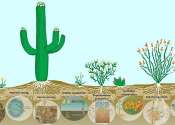3-D time-lapse imaging captures twisted plant root mechanics for first time (w/ Video)
Using an advanced 3-D time-lapse imaging system, a group of physicists and plant biologists from Cornell University and the Boyce Thompson Institute for Plant Research have discovered how certain plant roots exhibit powerful ...








